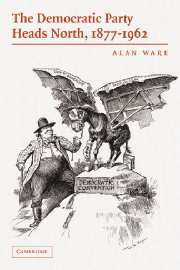Book contents
- Frontmatter
- Contents
- List of Tables
- Preface
- 1 The South and the Democratic Coalition
- 2 The Dynamics of Party Coalition Building
- 3 The Unstable Party Equilibrium, 1877–1896
- 4 The Re-assembling of the Democratic Coalition, 1896–1912
- 5 Woodrow Wilson and the Failure to Re-shape the Democratic Coalition, 1912–1920
- 6 How Could a Winning Democratic Coalition Be Constructed, 1920–1932?
- 7 Democratic Party Dominance or Restored Party Equilibrium, 1938–1952?
- 8 The Two Parties' Coalitions Come Under Threat, 1952–1962
- 9 Conclusions
- Appendix: Note on Data Sources
- Bibliography
- Index
7 - Democratic Party Dominance or Restored Party Equilibrium, 1938–1952?
Published online by Cambridge University Press: 15 December 2009
- Frontmatter
- Contents
- List of Tables
- Preface
- 1 The South and the Democratic Coalition
- 2 The Dynamics of Party Coalition Building
- 3 The Unstable Party Equilibrium, 1877–1896
- 4 The Re-assembling of the Democratic Coalition, 1896–1912
- 5 Woodrow Wilson and the Failure to Re-shape the Democratic Coalition, 1912–1920
- 6 How Could a Winning Democratic Coalition Be Constructed, 1920–1932?
- 7 Democratic Party Dominance or Restored Party Equilibrium, 1938–1952?
- 8 The Two Parties' Coalitions Come Under Threat, 1952–1962
- 9 Conclusions
- Appendix: Note on Data Sources
- Bibliography
- Index
Summary
No one has ever doubted that the Democratic Party scored a remarkable series of electoral successes between 1932 and 1936. Furthermore, there is also widespread agreement now that having used the Democrats' control of government to change public policy in America, FDR provided a reason for first-time voters to vote disproportionately for his party. What is much less clear is where this left the balance between the parties thereafter. The popular version of the account is that he created a majority coalition of voters for his party – the New Deal coalition. As Everett Ladd notes, “In the 1930s, a new majority party coalition, the Democratic, took shape”. This overly large coalition embraced white Southerners, farmers, Catholics, urban dwellers, those on lower incomes, union members, Jews, and, where they were not disenfranchised, African Americans.
There are three related problems with this characterization of the consequences of Roosevelt's actions. First, the idea that Roosevelt constructed a near-grand coalition is arguably correct in relation to his “all class” strategy in the early stages of the New Deal. However, by the mid-1930s, neither his policies nor the patterns of opposition to the Democrats that were emerging provide evidence that that had been anything other than a short-term strategy. Secondly, after the early years of the Roosevelt administration, when the members of these groups in the New Deal coalition voted, generally they did not give their votes overwhelmingly to the Democrats. African Americans were to be the notable exception.
- Type
- Chapter
- Information
- The Democratic Party Heads North, 1877–1962 , pp. 175 - 208Publisher: Cambridge University PressPrint publication year: 2006



